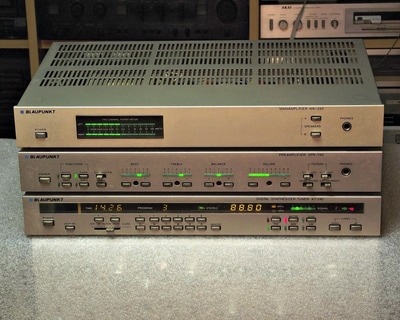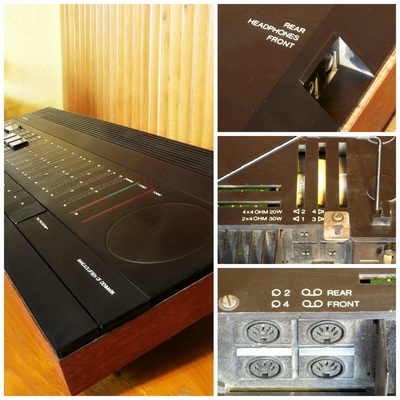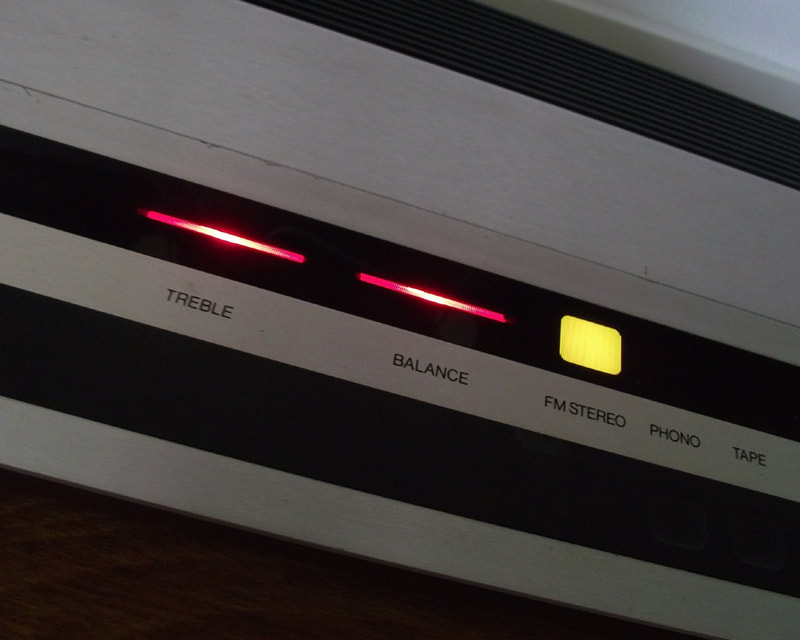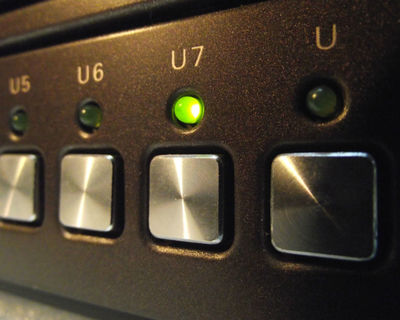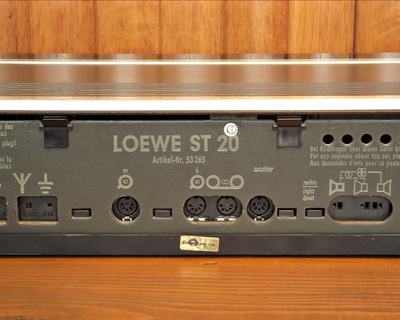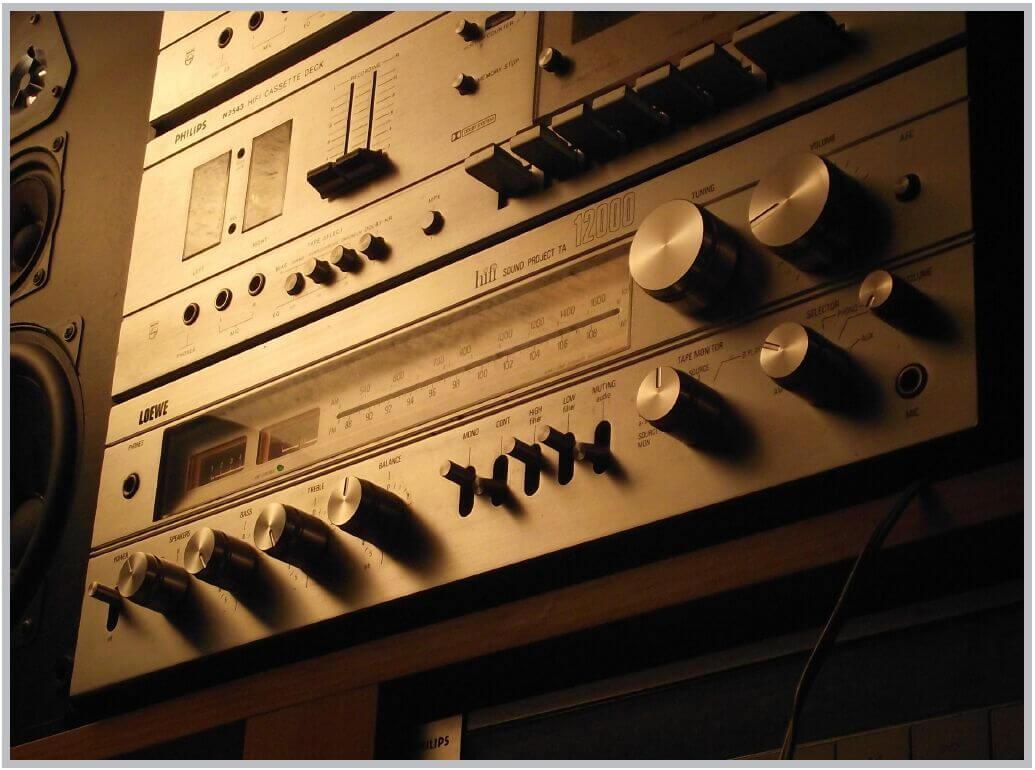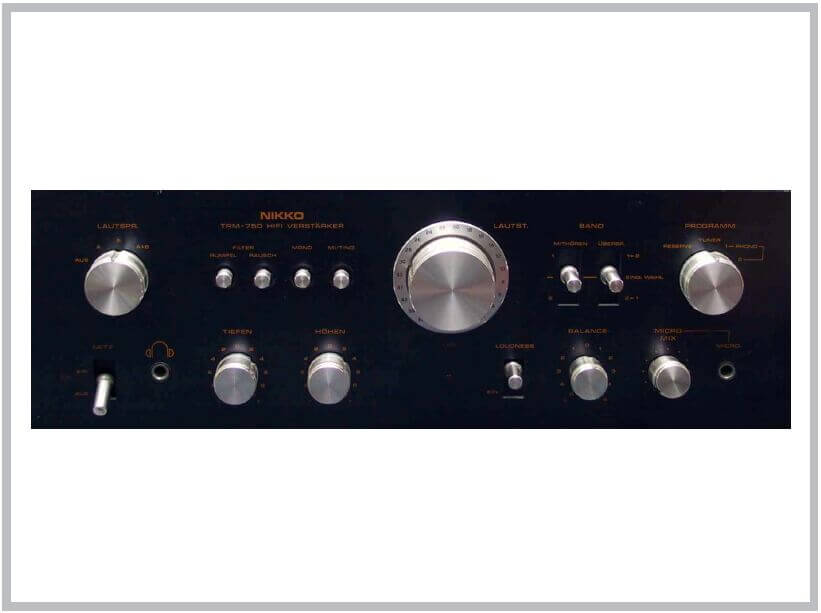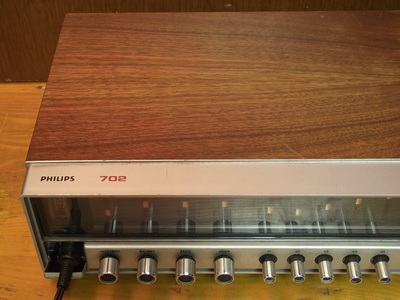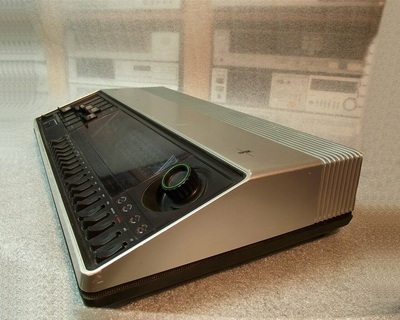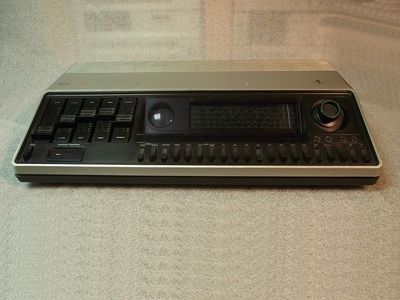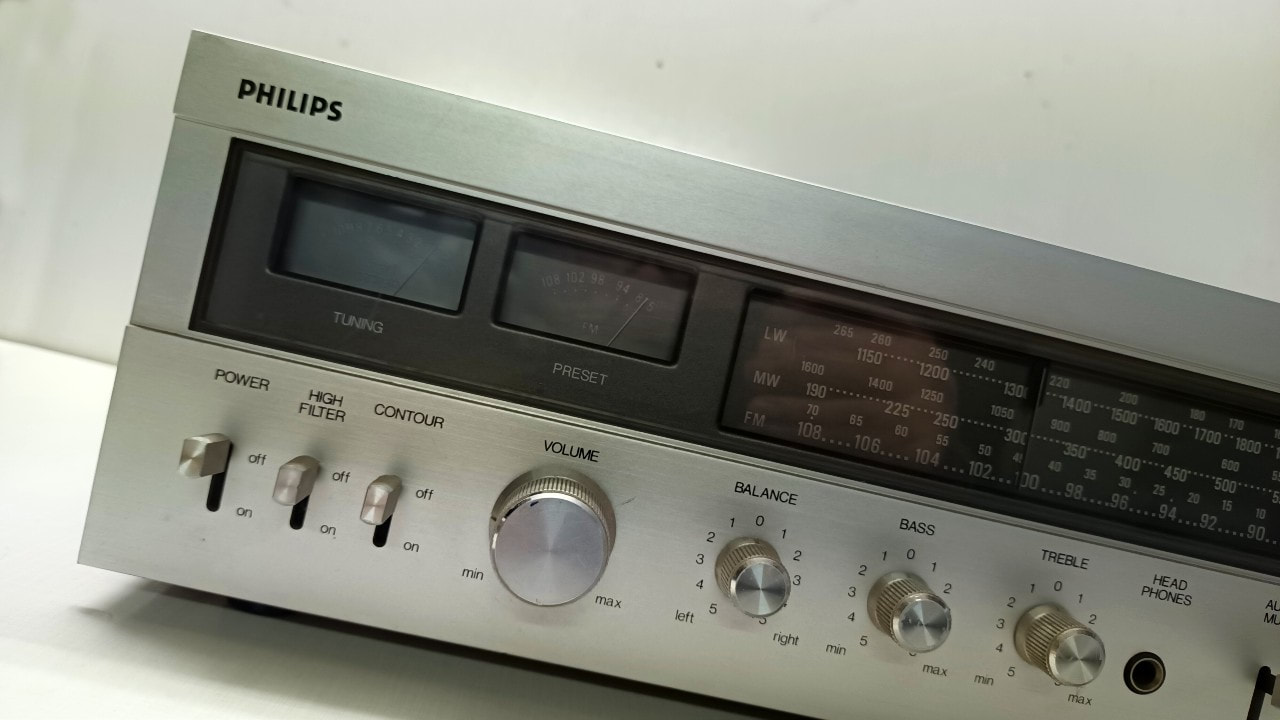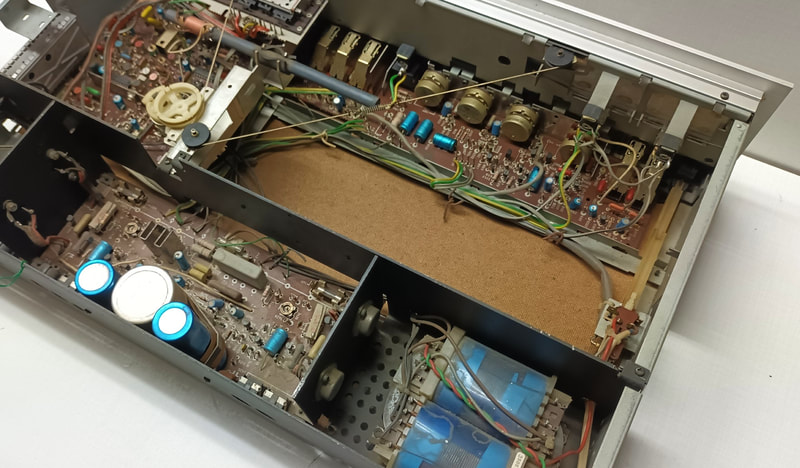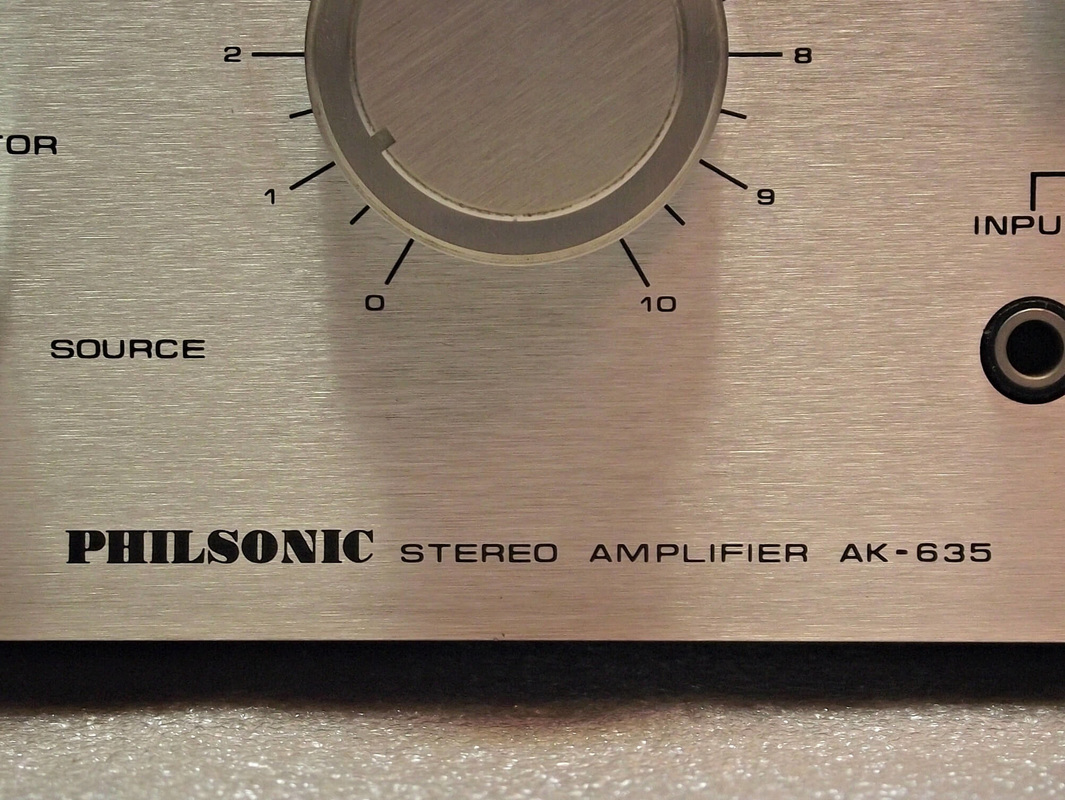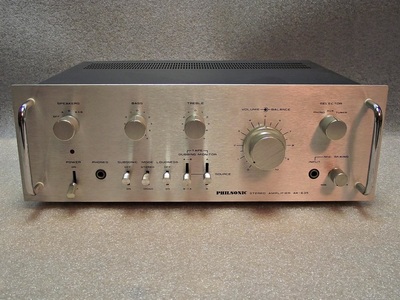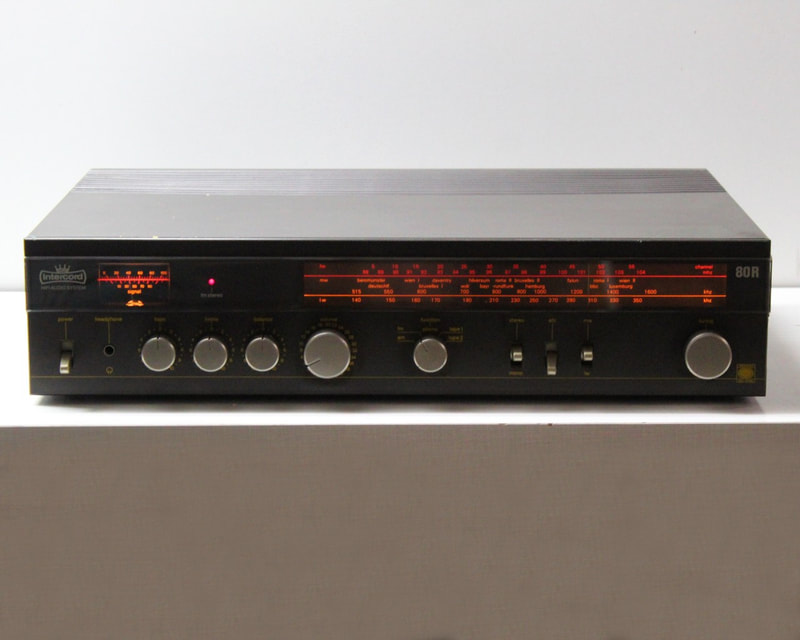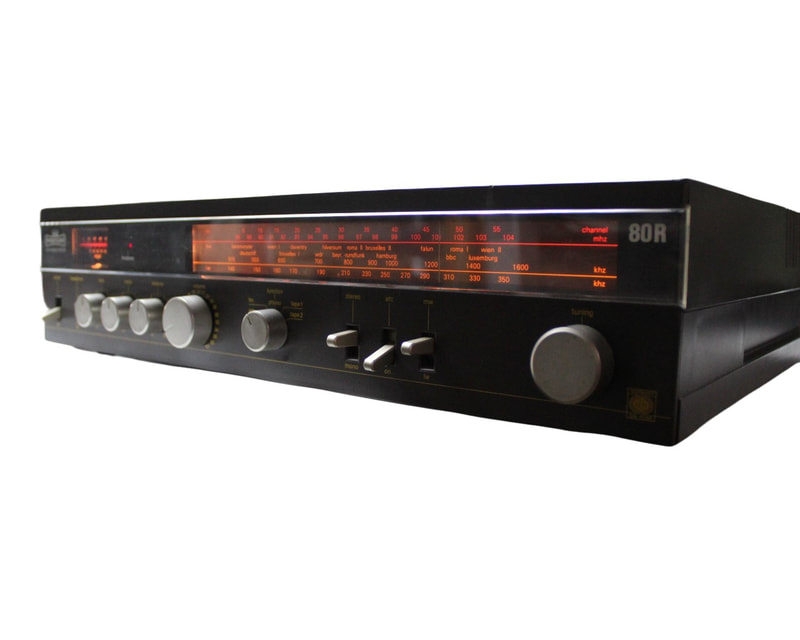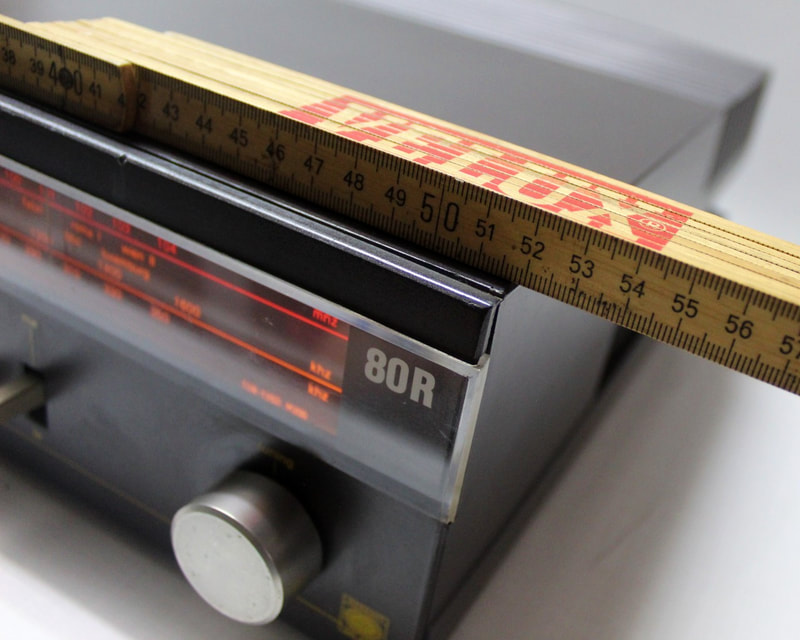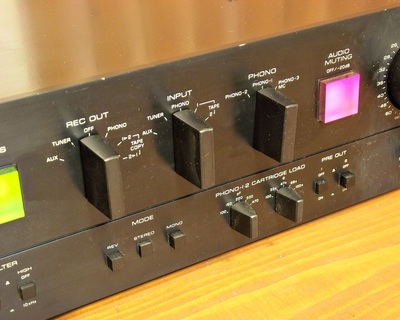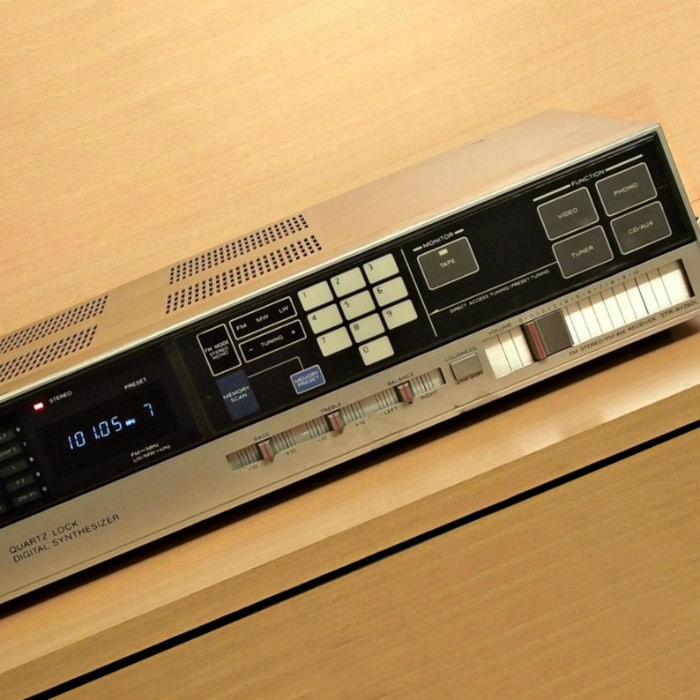AMPLIFIERS 1971 - 1980
The 1001 Hi-Fi Collection
BLAUPUNKT X-240 (1979)
BLAUPUNKT is mostly remembered for their car audio components but they also had a range of home Hi-Fi systems such as this remote-controlled Pre-Power amplifier from 1979. The adopted slimline design is following the design trends of the moment with a power amplifier labeled as "Produced in Japan Exclusively to Blaupunkt Specification" while the pre-amplifier and tuner have a Made in Germany sticker at the bottom. This must be the reason why there is a slight difference in shade between the Japan and German made front panels. The whole system can be remote controlled, unfortunately I don't have the original remote control, but they can be used with a compatible universal remote. This system was awarded in 1980 by the Stuttgart Design Center. The pushbutton control system with LED status display adds a nice visual touch to the unit and makes possible the remote operation but unfortunately, they do not age well making operation difficult. In the pictures you can see the following components:
XT-240 Tuner-Clock-Timer combo witch also acts as remote receiver, so the whole system can be remote controlled. The tuner has 29 random station memory, manual / automatic tuning and direct frequency input.
XPA-240 Preamplifier. Bass, treble, balance and volume are electronically controlled while between the pushbuttons there is a user adjustable preset control. Each time you turn the unit on the preset setting are activated so when you turn the system on you don't have to worry that you have left the volume turned up. If you make changes to bass, treble, balance or volume you can always revert to the preset settings with a touch on the "NORM" button.
MA-240 Power amplifier. Inside there are two STK modules mounted on a "Heat pipe" cooling system that gives a total power of 2 x 120-Watt music (2 x 65 W sinus). You can connect up to four loudspeakers to the amplifier and there is a nice LED power meter to display momentary power readings. Unlike many people think, the four-loudspeaker output is not for a "surround" sound in one room. This solution was a "multiroom" solution for those who wanted their favorite music to be available in two different rooms.
Cover Photo: Design 80 - Last update June 8th 2017
XT-240 Tuner-Clock-Timer combo witch also acts as remote receiver, so the whole system can be remote controlled. The tuner has 29 random station memory, manual / automatic tuning and direct frequency input.
XPA-240 Preamplifier. Bass, treble, balance and volume are electronically controlled while between the pushbuttons there is a user adjustable preset control. Each time you turn the unit on the preset setting are activated so when you turn the system on you don't have to worry that you have left the volume turned up. If you make changes to bass, treble, balance or volume you can always revert to the preset settings with a touch on the "NORM" button.
MA-240 Power amplifier. Inside there are two STK modules mounted on a "Heat pipe" cooling system that gives a total power of 2 x 120-Watt music (2 x 65 W sinus). You can connect up to four loudspeakers to the amplifier and there is a nice LED power meter to display momentary power readings. Unlike many people think, the four-loudspeaker output is not for a "surround" sound in one room. This solution was a "multiroom" solution for those who wanted their favorite music to be available in two different rooms.
Cover Photo: Design 80 - Last update June 8th 2017
BANG & OLUFSEN BEOMASTER 3400 (1975)
Stereo today - 4-channel tomorrow.
This statement was made by Bang & Olufsen in 1975 with the launching of the BEOMASTER 3400. This was in fact a 4-channel version of the previous BEOMASTER 2000 (also member of the 1001 Hi-Fi collection). By 4 channel we mean that it can be used - together with a BEOGRAM 3400 - as a quadraphonic system with a 4x20 W power output. If you slide the front-rear balance to front the amplifier will go into 2 channel (stereo front speakers only) mode with a nominal power of 2x30 W. This mode is confirmed by a red LED that lights up on the front panel. Being a quadraphonic amplifier without any built-in decoder means that you need a 4-channel tape recorder to reproduce the quadraphonic material - connected to the front and rear tape inputs. This configuration however allows you to connect two stereo tape recorders (one to front input the other to the rear input) and enjoy both stereo tape recorders in the same time in different rooms. (With 2 speakers in one room and 2 in another room) You can also connect two turntables to the amplifier, a quadraphonic model (BEOMASTER 3400) and a stereo turntable. These can be selected with the button under the slide panel. There are preset settings for 5 FM station that have the dial behind the slide panel on the right side. Being an extremely versatile unit, it can be used as stereo amplifier for loudspeakers placed in two different rooms or as a quadraphonic amplifier with all 4 speakers in one room. There is provision for two sets of headphones or one quadraphonic model. The BEOMASTER 3400 can be placed horizontally on a table or shelf system. Alternatively, it can be placed at an angle using the leg supports under the bottom, which can be tilted out. I prefer the angled placement as I'm sure Jacob Jensen, the designer of the unit would do. This amplifier today, in 2015, still produces a very good Hi-Fi sound - much more convincing than the 20 W/channel power might suggest.
Cover Photo: Coffee, Tea, Beomaster - Published January 15th 2015
This statement was made by Bang & Olufsen in 1975 with the launching of the BEOMASTER 3400. This was in fact a 4-channel version of the previous BEOMASTER 2000 (also member of the 1001 Hi-Fi collection). By 4 channel we mean that it can be used - together with a BEOGRAM 3400 - as a quadraphonic system with a 4x20 W power output. If you slide the front-rear balance to front the amplifier will go into 2 channel (stereo front speakers only) mode with a nominal power of 2x30 W. This mode is confirmed by a red LED that lights up on the front panel. Being a quadraphonic amplifier without any built-in decoder means that you need a 4-channel tape recorder to reproduce the quadraphonic material - connected to the front and rear tape inputs. This configuration however allows you to connect two stereo tape recorders (one to front input the other to the rear input) and enjoy both stereo tape recorders in the same time in different rooms. (With 2 speakers in one room and 2 in another room) You can also connect two turntables to the amplifier, a quadraphonic model (BEOMASTER 3400) and a stereo turntable. These can be selected with the button under the slide panel. There are preset settings for 5 FM station that have the dial behind the slide panel on the right side. Being an extremely versatile unit, it can be used as stereo amplifier for loudspeakers placed in two different rooms or as a quadraphonic amplifier with all 4 speakers in one room. There is provision for two sets of headphones or one quadraphonic model. The BEOMASTER 3400 can be placed horizontally on a table or shelf system. Alternatively, it can be placed at an angle using the leg supports under the bottom, which can be tilted out. I prefer the angled placement as I'm sure Jacob Jensen, the designer of the unit would do. This amplifier today, in 2015, still produces a very good Hi-Fi sound - much more convincing than the 20 W/channel power might suggest.
Cover Photo: Coffee, Tea, Beomaster - Published January 15th 2015
BANG & OLUFSEN BEOMASTER 1900 (1976)
A Bang&Olufsen Classic, a Design icon. This is the Beomaster 1900 introduced in 1976 with a ground-breaking design language developed for Bang&Olufsen by Jakob Jensen. This receiver was way ahead of its time, with a design and operation that differed dramatically from other contemporary products. One famous advert showed Japanese engineers (with their cameras) looking inquisitively and surprisingly to this wonder of modern technology. The receiver stood out not just because of its smooth appearance but by the way it is controlled. It's most attractive and innovative feature is the touch-sensitive (in 1976!) control panel for the most used switches of the unit such as volume, input select, FM preset select and power off. All the secondary features and adjustments are placed behind the full-width aluminum dampened-hinged lid. Above the touch-sensitive control panel there is a full-width function feedback display for volume level, tone control, balance and selected source. To avoid unpleasant surprises when turning the unit on (such as high volume), there is a preset volume switch that can be set to low/medium/high position.
If you think that the Beomaster 1900 from Bang&Olufsen is all about design and less about sound then you're in for a surprise. It's 30W/ch (DIN 4ohm) amplifier is up in terms of sound quality with most amplifiers with similar power rating from the same era (or more modern). The sound still can be considered good by modern standards as well. All connectors are hidden at the bottom of the unit in a recessed panel and they are all DIN standard plugs. The Beomaster 1900 has provision for two sets of speakers for multiroom use but it also can be expanded to a "pseudo-surround" sound system. Utilizing Bang&Olufsen's optional ambiophonic circuitry with the use of the ambio box and two additional speakers you could achive Ambiophonic Sound from any Stereo source. (Today we would call this a pseudo-surround mode). The Beomaster 1900 is also part of the MoMA (Museum of Modern Art - New York). It was also one of the very few occasions when between 14 April to 18 June 1978 MoMA had an exhibition dedicated to one designer/manufacturer only. This was called: Bang & Olufsen: Design for Sound by Jakob Jensen. Externally the unit has a beautiful finish, a combination of large brushed aluminum panels, high quality plastic and real wood veneer on the side and front. There was also available a version with white finish instead of the wood veneer. The unit can be placed both on a shelf or hung on the wall. The Beomaster 1900 remained in production for several years even when the remote-controlled replacement, the Beomaster 2400 was on the market. Dimensions: 620x60x250 mm | Weight: 7.6kg. | Original sale price: 1298 DM in Germany.
Cover Photo Art: Gentlemen Take (non)Polaroids - Published: November 15th 2021.
If you think that the Beomaster 1900 from Bang&Olufsen is all about design and less about sound then you're in for a surprise. It's 30W/ch (DIN 4ohm) amplifier is up in terms of sound quality with most amplifiers with similar power rating from the same era (or more modern). The sound still can be considered good by modern standards as well. All connectors are hidden at the bottom of the unit in a recessed panel and they are all DIN standard plugs. The Beomaster 1900 has provision for two sets of speakers for multiroom use but it also can be expanded to a "pseudo-surround" sound system. Utilizing Bang&Olufsen's optional ambiophonic circuitry with the use of the ambio box and two additional speakers you could achive Ambiophonic Sound from any Stereo source. (Today we would call this a pseudo-surround mode). The Beomaster 1900 is also part of the MoMA (Museum of Modern Art - New York). It was also one of the very few occasions when between 14 April to 18 June 1978 MoMA had an exhibition dedicated to one designer/manufacturer only. This was called: Bang & Olufsen: Design for Sound by Jakob Jensen. Externally the unit has a beautiful finish, a combination of large brushed aluminum panels, high quality plastic and real wood veneer on the side and front. There was also available a version with white finish instead of the wood veneer. The unit can be placed both on a shelf or hung on the wall. The Beomaster 1900 remained in production for several years even when the remote-controlled replacement, the Beomaster 2400 was on the market. Dimensions: 620x60x250 mm | Weight: 7.6kg. | Original sale price: 1298 DM in Germany.
Cover Photo Art: Gentlemen Take (non)Polaroids - Published: November 15th 2021.
BANG & OLUFSEN BEOMASTER 2200 (1977)
The BEOMASTER 2200 was introduced in 1977 and it replaced the previous BEOMASTER 2000 (also part of the 1001 Hi-Fi stereo museum). This is another B&O product that was designed by Jacob Jensen. It is a 2 x 40-watt FM/AM receiver with 5 FM presets plus one manual tuning that uses the main display as frequency indicator. (If you select FM, only the FM scale will light up. Changing to AM the FM scale light turns off and the AM scale lights up). On the left-hand side, the aluminium surface hinges up under damped control. Here you can find the tone controls, the FM preset block that rises to allow the adjustments to be made. The sockets for speakers, tape, phono and aerial were also here and they were horizontally placed. This way all the cable connectors were hidden under the aluminium lid and it allowed access to them without moving the unit. The sound of this amplifier is very good. Just connect to this unit the BEOGRAM CD X and the PIONEER CS-797 loudspeaker and you have a wonderful system.
DUAL CV 1200 (1978)
This is the DUAL CV 1200 stereo amplifier from 1978, Made in Germany. It was probably the last time a DUAL product had Made in Germany written on it. This is a compact 40 W / channel amplifier that was available with this metallic-silver front or in metallic-brown. The front panel is still an aluminium front panel and as you can see in close-up pictures the knobs are also machined aluminium pieces. Here are some interesting details: at the back there are DIN standard connectors alongside RCA jacks. The standard in Germany was the DIN plug so these RCA plugs are so close that it's almost impossible to connect a cable to them. The speaker connectors are in two rows, one with clip terminals and one with DIN speaker plugs. Usually, German speakers came pre-equipped with DIN plugs. Regardless of this multitude of speaker connectors the amplifier can only be used with two pairs of speakers, selectable from the front panel. On the front panel you will see that the headphone and microphone plugs are mounted in a large hole. That's because some models had DIN plugs mounted here which are larger in diameter. Speaking of the microphone input. This one can be used in "DJ style" to speak over the music you hear from a selected source, or without playing any music.
Cover Photo: Made in Germany - Published January 15th 2014
Cover Photo: Made in Germany - Published January 15th 2014
DUAL CR 1750 (1979)
DUAL computer-controlled synthesizer receiver, this is the DUAL CR 1750 from 1979 in metallic-brown. It was made under Dual specifications in Japan. According to the DUAL catalog of the time this model was available from October 1979. The power amplifier and pre-amplifier section of this unit can be separated. As a simple upgrade you could use this receiver as a pre-amplifier with a more powerful power amplifier, or you could "clean up" the sound using another preamplifier and using this amplifier as a power amplifier only. Power rating for this amplifier is 2 x 50-watt continuous power. For a more "flexible sound" you could just insert a graphic equalizer between "pre-out" and "main input".
GPM-8020A (1977)
Not much info about this amplifier except the fact that it was made in Korea. It seems that the GPM 8020A is a model designation (see the back of the amplifier) and not a manufacturer brand. It was built this way probably to be sold to various manufacturers who then, will put their logo on the front of the amplifier. The build quality is very good (Japanese power transistors) and there are plenty of inputs too (2 PHONO, 2 AUX, 2 TAPE play/rec and TUNER) The amplifier can be also used as a preamplifier with a different power amplifier or as a power amplifier with a different preamplifier. The power rating could be something around 70-80W / channel with a typical 70's sound.
Cover photo art: Sapceman came travelling (with music) - Published 15th april 2014
Cover photo art: Sapceman came travelling (with music) - Published 15th april 2014
GRUNDIG R 35 SUPER HIFI (1978)
The GRUNDIG R 35 was a new receiver in the 1978 model range. It was available with both brown metallic and silver front panel. This is a fully loaded model with all the high tech features you could find on a receiver in 1978. The source selector is feather-touch electronic controlled together with the 7+1 FM memory preset selector. For tone control beside the volume and balance control we have tone control for bass, mid and treble, together with loudness control and high filter. There is provision for two sets of loudspeakers for stereo sound reproduction in one room or two different rooms if desired (all inputs and outputs use DIN standard plugs). On the front panel there is provision for two sets of headphones, just like on the matching GRUNDIG CNF 300 SUPER HIFI cassette deck from our collection. Behind a small flip-down panel we have a "red key" that will be used to tune into your favorite station for each channel that will be selected from the memory keys. For the frequency display of these presets there is a separate VU-meter like frequency indicator. Power rating according the DIN 45500 standard is 2 x 50/30 W (Music/Nominal)
Cover Photo Art: Mothership - Published November 15th 2018
Cover Photo Art: Mothership - Published November 15th 2018
LECSON AC1 (1973)
Winner of DESIGN COUNCIL Award for Consumer Goods, this is the LECSON AC1 preamplifier made between 1973 and 1974. This iconic space-age styling product was designed by Boothroyd / Stuart. They later went on to successfully launch MERIDIAN Audio in 1977. The preamplifier offers Bessel characteristic filters at 35 Hz, 5 kHz, 8 kHz and 13 kHz, and the tone controls are +/- 8 dB at 10 kHz and +/-12 dB at 100 Hz. All audio sockets are executed in the DIN format. There were three matching power amplifiers made, the AP1 / AP1X / AP3. There is a fairly complex interface between pre-and power amplifier, so it is a little bit difficult to use the pre-amp with a different power amplifier, but possible. For example, the headphone socket located on the pre-amp receives the signal that is coming back from the power amplifier.
Cover photo art: Any Colour You Like - Published November 15th 2013
Cover photo art: Any Colour You Like - Published November 15th 2013
LLOYD'S B 795 (1977)
Before today's "surround sound system" at the beginning of the 70's there was a multichannel amplifier technology trying to break through. It was a 4-channel technology available in several formats. This LLOYD'S receiver is using the so called SQ QUADRO solution. This is an unfamiliar brand but looking at the inside of the unit it seems that this was made in Japan. If you look at the pictures you will notice how the tuning needle changes color, where GREEN is for "not tuned" and RED for tuned in STEREO. Another interesting solution is the use of RCA plugs for all 4 loudspeaker connectors. Well, maybe it is not so unusual because you can find similar solution on modern midi surround systems too. The silver version with added low and high filter of this amplifier was called LLOYD'S B629 - Qudratic Sound Four Channel Stereo Receiver.
Cover photo art: For People With Four Ears
Cover photo art: For People With Four Ears
LOEWE ST 20 sensotronic (1971)
This is a top-class receiver from 1971 with high sonic qualities delivered by a 25 W/ch amplifier. The elegantly designed LOEWE ST 20 was part of the "line 2001" design series and it was awarded in 1973 by the "design center Stuttgart". Visually the most striking elements are the tuning dial that turns to black when the unit is switched off and the touch sensitive illuminated preset selector (sensotronic). The 7 sensotronic memory presets can be used for FM stations only but the radio section can also receive AM, LW and SW radio programs. Using the LOEWE ST 20 as a center unit for your Hi-Fi system you can connect a tape recorder and two turntables for music reproduction. Alongside the usual bass and treble controls there are low and high filters, a tone defeat switch and a pseudoquadro effect for the occasion when the unit is used with 4 loudspeakers. Real Quadro (SQ, CD 4) sound can be achieved with the matching additional LOEWE QV 300 unit. Behind a flip down panel on the front there is provision for two sets of headphones that use DIN standard plugs. The basic concept of this system is that when you plug the headphones in one position you will have sound from both speakers and headphones. Unplug, rotate and reinsert the plug and the loudspeakers are switched off so you will only hear sound from your headphone. On this LOEWE ST 20 one headphone plug keeps the loudspeakers on all the time, while the second one can switch off the loudspeakers for a more personal sound experience using your headphones. Our unit was in storage for several years yet the presets were spot on when we turned this radio on in 2017 for this photo session / sound test. This is something exceptional as all the other units that use this manual tuning / memory system are generally out of tune after several years of storage. The unit works fine since 1971, even the volume / bass / treble controls work without any scratch in 2017.
Cover photo art: Megaherz (From Station to Station) - Published September 15th 2017
Cover photo art: Megaherz (From Station to Station) - Published September 15th 2017
LOEWE TA-12000 Typ SX6776 (1979)
This is the LOEWE SX 6776 stereo receiver from 1979 with FM and AM, 90 Watts output per channel (sinus DIN - 4 ohm), MOS-FET FM front end, PLL decoder, FM and audio mute, micro mix, scratch and rumble filters, direct-coupled OCL semi-complementary power amplifier. This is how the brochure presented the product......a PHILIPS product, that was made for PHILIPS by Foster of Japan. Having the same silver aluminium front and knobs, this was sold as SOUND PROJECT TA 12000 with: PHILIPS, LOEWE, ERRES, DUX, HORNYPHON, SCHNEIDER (France), MEDIATOR and PYE logo. There was also an ARISTONA AR2600 model with black front plate. (The others had black versions too). The original PHILIPS model was the AH 686 TA, with a different front panel, different monitor switch and added selector for their MFB loudspeakers, but then again, this MFB version was sold also with RADIOLA logo. With its high-power output (using Sanken transistors) the sound quality is very good.
NIKKO TRM-800 (1975)
The NIKKO TRM-800 (or A-800 in Japan) was the top-of-the-line model in the NIKKO amplifier range from this model year. It's a very nice 65 W/channel (8 Ohm, 20-20.000 Hz) amplifier that can be used as a standalone amplifier or it can be "switched" to work as a preamplifier (with another power amplifier) or as a power amplifier (with another preamplifier). There is provision for three sets of loudspeakers (for different rooms) however only two pairs can be used simultaneously. The tone controls can be selected at which frequency to make the adjustments, and it's 500 Hz or 250 Hz for bass and 2.5 khz or 5 kHz for treble. This way you can use any loudspeaker from that period of time and get the best results from them in any room. The filters are also selectable for different frequencies, it's SUBSONIC or 50 Hz for the low filter and 12 khz or 7 kHz for high filter. There are plenty of inputs as well - two auxiliary, two phono, tuner and two tape with both way dubbing. There is a second, front panel input labelled tape2 that will switch off the tape2 from the back panel if in use. The finish of this unit is high quality too with aluminium front panel and knobs and real wood veneer top cover. A real joy to use and listen for any vintage audio lover. Made in Japan.
Cover Photo: Vivid Memories - Published 15th October 2014
Cover Photo: Vivid Memories - Published 15th October 2014
NIKKO TRM-750 (1978)
This was my first "true" amplifier. It's a NIKKO TRM-750 amplifier, made in Japan using NEC power transistors. The power rating is 2x55 W at 8-ohm 20-20.2000 Hz. It was made for the German market so all the lettering was in German, with orange color. The power rating according to German standards was 2 x 100-Watt music and 2 x 75-Watt Sinus DIN 4 ohm. At the back as you can see there were only DIN plugs but the sound was superb. The amplifier could also be used as power amplifier only, with another preamplifier, or it could be used as a preamplifier with a different power amplifier. This was a way to upgrade and improve the sound quality of your existing amplifier.
PHILIPS RH 702 (1971)
The PHILIPS 702 was a new receiver for the 1971 line-up. Proudly presented on the brochure cover, this is a 2 x 18 Watt "Music power" amplifier with a 5-band radio and 5 FM presets. According to the DIN 45 500 Norm the amplifier is rated 2 x 12 Watt "Sinusleistung" (continuous power) at 4 ohm. As a design feature we have to notice the so called "thermometer" display used for tone control and FM presets. These indicators move up and down according to the settings made on the knobs and act as status display for the chosen values. At the far left there is a 5 pin DIN headphone plug behind a small "door". If you push this door, the switch behind turns off the loudspeakers and pushes open the door, allowing you to flip it down and insert the headphone plug. Read more about the system built around this amplifier.
PHILIPS RH 752 (1975)
The PHILIPS RH 752 amplifier-tuner combination was the top model in the 1975 PHILIPS lineup. It is a 30 W/ch Stereo Hi-Fi amplifier and AM/FM radio combination. The FM section has 5 FM presets and a special touch control electronic station search. The amplifier can be used up to 4 speakers either as 2 stereo sets for different rooms or all 4 speakers in one room for a special PHILIPS STEREO 4 sound effect. To further enhance the performance of the system the amplifier can be used as a pre-amplifier with the special PHILIPS MFB loudspeakers range. Headphone and microphone sockets are conveniently located behind a small sliding door on the front plate. The unit measures 63 x 12.2 x 34.4 cm in a fascinating silver-/black combination plastic housing.
Cover photo: original PHILIPS brochure - Published December 15th 2015.
Cover photo: original PHILIPS brochure - Published December 15th 2015.
PHILIPS 794 (AH794TA) (1978)
Philips introduced the 794 Receiver (called 794 Tuner-Amplifier on some markets) in 1978 as part of their "New International Styling" concept to face competition from far-east. No need to say that this is a highly competitive model with some interesting and innovative features. Starting right at the front we have this brushed aluminum front panel, a much wider than usual front panel that measures 570mm in width, complete with aluminum control knobs. The power rating of the amplifier section is a decent 40W/ch at a total harmonic distortion of 0,7%. If you think these technical measurements are not that impressive then wait to hear how it sounds. Not only this amplifier system allows you to use two pairs of loudspeakers (to be used in two different rooms) but it will also operate with the sensational MFB loudspeaker system from Philips. Using a MFB loudspeaker from Philips will basically turn this system into a "high-end" audio system. Of course this was not called High-End in those days, it was simply a high-performance/top model from a reputable manufacturer, the best you could get. At the back of the unit we have inputs for two tape recorders (in/out) and a turntable (phono) input. All the inputs located on the back panel are DIN standard socket but the front panel headphone socket is a "International Standard" 6,3mm headphone socket. For "perfect listening pleasure" we have a high filter, low filter but also contour circuit for low listening levels. The radio section features LW, MW and FM-Stereo radio reception with 5-FM presets. The tuning frequency of the selected preset is displayed by a VU meter like indicator situated to the left of the usual tuning meter. According to period accurate brochure the matching turntable of a system based around the 794 TA would be the Electronic 777 turntable and the N2541 cassette deck. In our "Hi-Fi System" photo you can see the 794 TA partnered by a N2543 cassette deck (one of two from our collection) which is nothing but a N2541 in a wider housing...yet still not wide enough to match the 794 TA.
Cover Photo: Extended Stereo - Published February 15th 2025
Cover Photo: Extended Stereo - Published February 15th 2025
PHILSONIC AK-635 (1978)
PHILSONIC. Have you ever heard of this brand? Probably not, but you've surely seen one of their products. That's because PHILSONIC was a brand name used by Inter-National Korea Electronics (INKEL). INKEL was, and still is the company that manufactures SHERWOOD components (so now you know it). At one point they were making SAE components too, branded inkel/SAE. This vintage amplifier was available in 1978 as the original INKEL AK-635 and rebadged under several brand names such as: PHILSONIC AK-635, MACLAIR AK-635, McLaren ML-3838, EAGLE A 7400, TECTRONIC SA-535 and SHERWOOD S-402 CP. It has a power rating of 45 watts/channel with a distortion less than 0.08% and a solid construction.
Schneider TEAM 200R | Intercord 80R (1980)
Intercord Tonträger GmbH was a German music label based in Stuttgart. According to the Intercord-Story brochure, the company was "one of the most creative centers in the international music market". The most important foreign partner was the Mute Records label , which Intercord represented for the German-speaking region from 1981 and whose artists Depeche Mode, Yazoo, Erasure, Nick Cave and the Bad Seeds and Moby brought the company sales in the millions and important market shares. As a consequence, the here presented Intercord 80R stereo receiver is nothing but a rebadged Schneider TEAM 200R receiver. The power amplifier section uses a pair (one for each channel) of SI-1020H hybrid power amplifier modules manufactured by the Sanken Corporation of Japan. These modules deliver 2x40/22 Watt Music/Sinus power. The construction itself is unique too, featuring two power transformers and electronics mounted on a steel chassis that slides inside the plastic box much like a matchbox. This offers great serviceability and a strong and stable plastic box to house the electronics. All plugs are DIN standard with input for two tape recorders, turntable and one pair of loudspeakers with an additional front panel headphone socket. The receiver is also unusually very wide measuring 518mm. We have in our collection the matching cassette deck too.
Cover Photo Art: Dual Power - Published 15th June 2023
Cover Photo Art: Dual Power - Published 15th June 2023
TELEFUNKEN CONCERTO HiFi 404 (1972)
TELEFUNKEN, the inventor of the magnetophon . Here is a nice receiver from their 1972 lineup. It has a power rating of 2 x 22-Watt Sinus (continuous power) and 2 x 40-Watt Music Power. The radio section has manual FM, 7 FM presets and AM sections. It has a built in FM antenna, so the radio can work well without an external antenna. You can connect up to 6 speakers to this amplifier. Two speakers for your main listening space (Room 1) and another two for your second listening space (Room 2). The remaining two speaker sockets are for an extra pair of speakers for (Room 1) to be used in a pseudo-quadro configuration. This however was only to achieve a 4 speaker "surround sound" from a STEREO source, and not a Quadro sound from a Quadro source. For the headphone there is a 5 pin DIN socket, where the headphone plug can be connected in two ways. In position one you have sound from your speakers and headphone too. Unplug, turn it 180 degree and plug in for headphone operation only. Price was 925 DM (deutsche mark)
(The "Electric Lady" is "connected" from the 1927 Fritz Lang movie "Metropolis")
(The "Electric Lady" is "connected" from the 1927 Fritz Lang movie "Metropolis")
TELETON A 300 (1976)
In a German brochure from the 70's this amplifier was presented as "Teleton - Deutsches Gesicht, Japanischer Herz" (German looks, Japanese heart). It was in fact a brand name used by Mitsubishi for the European market. Following the German design trends of the 70's the unit was designed by the "Rommel und Schoen design" agency, and that was the German look. It has a very low power output, 2 x 10 W THD 1% 8-ohm continuous load and 2 x 19 W music power. The manual says that these values are surpassing the German DIN Hi-Fi 45500 specifications. I have to confirm you that the sound quality of this small amplifier is very good if you have the right combination of source and loudspeaker for the system. Because this model was specifically made for the German market it has only DIN input plugs and DIN speaker plugs. You can connect up to four speakers to this unit and with the "q4" switch on, you can achieve an ambiance (spatial, surround) effect from a stereo source.
YAMAHA C-4 (1978)
This is the YAMAHA C-4 pre-amplifier from the 1001 Hi-Fi collection, a model introduced by YAMAHA in 1978. The C-4 is a high-performance pre-amplifier with low distortion and versatile controls, one of the most sophisticated pre-amplifiers ever built. Instead of the fixed frequency tone control for bass and treble found on other amplifiers the C-4 allows you to select the frequency (turnover frequency) where you perform tone reducing or boost. Additionally activating the tone bypass switch the DC equalizer connects with the DC flat amplifier directly, and accordingly ensures high sound quality. There is a low frequency noise reduction circuit to be used with turntables and a high filter to reduce tape hiss if necessary. You can connect up to 7 sources to the C-4, two tape recorders with in/out and both way copy facility, tuner, aux and 3 turntable inputs. The Phono3 input accepts turntables equipped with MC type cartridge while Phono1 and 2 inputs accept turntable with MM type cartridge. For Phono 1 and 2 inputs additionally, you can select the cartridge load resistance and load capacity ensuring optimum match between the used cartridge and the phono equalizer amp. The availability of a varying load capacity means different characteristics also obtainable from the same phono cartridge to permit fine selection of sound quality. The 4-gang VOLUME control with dB display fade both equalizer amplifier and flat amplifier output stages simultaneously so as to greatly improve the signal to noise ratio in a small volume. There are two pre out connectors/switches that allows you to use two power amplifiers. There is also a dedicated headphone amplifier with separate volume control. Made in Japan.
Cover photo art: Detailed Elements - Published October 15th 2016
Cover photo art: Detailed Elements - Published October 15th 2016


